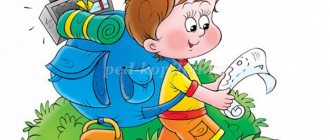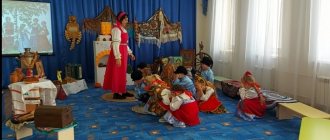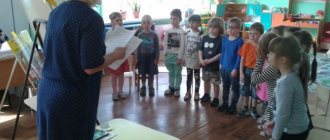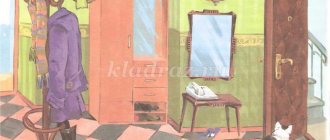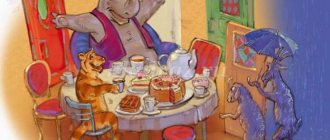Summary of the integrated lesson “Educational game-trip to the winter forest.” Senior group
Summary of an integrated game lesson in kindergarten in the senior group with the presentation “Educational game-trip to the winter forest”
This material will be useful for teachers of children's institutions working with children 5-6 years old to consolidate knowledge on the topic of the life of wild animals in winter.
Purpose of the lesson: to expand children’s understanding of the life of wild animals in winter through the use of educational games. Objectives: Expand children's understanding of wild animals, their habits, and way of life in winter natural conditions. Fix the names of animals and their cubs. Develop dialogical speech skills, the ability to give complete answers to questions. Develop independent answers and judgments. Develop auditory attention and visual memory. Improve gross and fine motor skills. Teach the development of clear coordinated movements in conjunction with speech. Fix quantitative and ordinal counting within 10; the composition of the numbers 5 and 6 from two smaller ones, teach children to compose and write down the solution to a problem, practice finding and laying out geometric shapes according to a pattern, creating a certain pattern, promote the development of attention, memory, and logical thinking. Develop spatial orientation. Foster a love of nature, interest and a desire to learn more about wild animals. Materials and equipment: presentation in the form of slides, didactic game “Fold the picture”, “Tangram”, 6 toys of wild animals, silhouette images of hedgehogs without spines, clothespins, a picture of a labyrinth for each child, mushrooms, notebooks, pencils, rope, models of stumps. Audio recording: winter melody.
Progress of the lesson
Organizational moment. A melody sounds. Pictures of winter change on the screen.
Educator: It’s the most beautiful and magical time of the year outside, tell me what time of year it is now? What month? Guys, do you want to visit the winter forest? Well, let's go on a trip? A lot of interesting things await us in the winter forest. Dynamic exercise “For a walk” I invite you to go for a walk in the winter forest. We guys can't find a more interesting adventure. Stand next to each other, hold hands tightly. Let's go for a walk along the paths, along the paths, in the forest. We can always find many, many interesting things in the forest. Educator: The road to the forest will be difficult, we will need to overcome many obstacles. Ready? Then let's go! Look, the path is blocked by stumps, you need to go around them. (Children move like a snake between models of stumps) Educator: There are high snowdrifts in front of us, we will have to walk through them raising our legs high. (Walking with high knees). Educator: There is a deep ravine ahead, it’s good that there is a tree thrown over it. You need to walk along it carefully so as not to fall. (Moving along a rope, maintaining balance) Educator: So we came to the forest, admire the beauty of the winter forest. (On the screen is a picture of a winter forest).
Tell me, guys, how do they behave in the forest? (In the forest you need to be attentive and careful, you can’t make noise) What is a winter forest like? Tell me. (Children come up with words-attributes for the phrase “winter forest”). Educator: It’s so good here. Let's breathe in the clean frosty air. ( Breathing exercises ). Inhale through your nose and exhale slowly through your mouth. You will find out who we will visit by completing the task. I suggest you put the pictures together from the parts. (Children put cut pictures on the carpet)
.
Who are we going to talk about today? (about wild animals)
.
What is it like for animals in the forest in winter? What do you think is their main concern? (Children answer.) Game “Who is in what place?” Children approach the table, where forest dwellers (soft toys) are laid out in a row. They need to name which animal counts, which one they collected, who is “in front”, “between”, “behind”, “after”. Children call: Hare first, fox second, wolf third. The wolf stands behind the fox, in front of the squirrel, and so on. Educator: Let's sit down at the edge of the forest and remember the finger game: Hedgehog, bear, badger, raccoon (fingers alternately greet the thumb, starting with the index finger on the left hand).
They sleep in winter every year
(the fingers alternately greet the thumb, starting with the little finger on the left hand).
Wolf, hare, lynx, fox
(fingers alternately greet the thumb, starting with the index finger on the right hand).
And in winter you will find it in the forest.
(fingers alternately greet the thumb, starting with the little finger on the right hand).
I invite the children to go to the tables.
Meet the squirrel. Who lives in a forest hollow? Who eats all the nuts? Who dries mushrooms on branches? With tassels are her ears. Fluffy warm tail, like a hot water bottle, Well, of course, this is Squirrel. Didactic exercise “Arrange the mushrooms.” Educator: Guys, let's help the squirrel arrange the mushrooms. In the basket where the number 5 is, you need to arrange 5 mushrooms in different ways. In the basket where the number 6 is, you need to arrange 6 mushrooms. (Composition of a number from two smaller ones).
The children at the tables are doing the task.
Then the answer appears on the screen, and the children check that they completed the task correctly. Well done! Meet the hedgehog. Who's the prickly one? Lives in the forest? Who isn't afraid of the fox? He doesn’t run away from her: He curls up in a ball and lies there, with neither eyes nor legs visible? Did you find out? After all, this is a hedgehog. Game with clothespins “Prickly hedgehog” Educator: While the hedgehog was running, he lost all his needles. We need to help him. Children attach thorny clothespins to the silhouette image of a hedgehog. Meeting the bunny In winter he wears a white fur coat, but in summer he turns gray. I ran through the forest all day, but I wasn’t even tired. The trickster fox is terrible for him and the gray wolf. Carrot muncher. He knows a lot about cabbage. Who is he? Guess what! We call him bunny. Didactic game “Feed the hares with carrots” Educator: I made up such a task. The bunny ate 3 large carrots and 4 small ones. How many carrots did he eat in total?
On the screen there is a picture with a recording of the solution to the problem. Educator: You need to compose a problem and write down its solution in your notebook. The bunnies have eaten and invite you to play with them. They have very unusual eyes, which is why they are called slanted. Are you taking care of your eyes? Let's do gymnastics for them. (children repeat after the teacher)
We will close our eyes. We find ourselves in a dark fairy tale.
We will gently stroke the eyelids. The eyes must be opened. Up and down, and right, left Let's play with our eyes. We'll play a little, we'll blink our eyes. This is the end of gymnastics. Oh, well done bunny. Dynamic “Animal exercise” Hares are jumping and jumping in the forest - white balls. (Hands at the chest, like the paws of a hare; jumping.)
Jump - hop, jump - hop - The little bunny stood on a stump
(Jumps forward - back.)
Lined everyone up in order, He began to show exercises.
Once! Everyone walks in place. Two! They wave their hands together. Three! They sat down and stood up together. Everyone scratched behind the ear. We reached four. Five! They bent over and bent over. Six! Everyone stood in a row again, They walked like a squad. Meet the fox. Who's sneaking between the pines? Does he wear a fire coat? Whose tail is there in the thick grass Flashing like gold? This is a beautiful maiden, a bright red fox. Game "Tangram" It is proposed to post images of a fox and a hare.
Educator: What figures are needed to lay out an image of a fox and a hare. How many figures does the image of a fox and hare consist of? Acquaintance with a wolf He makes friends only with a fox, This animal is angry, angry. He clicks and clicks his teeth, A very scary gray wolf. Onomatopoeia “The wolf howls” Educator: Now you and I will turn into wolf cubs. Wolves howl loudly in winter. How do they howl? Children say a drawn-out “Oooh” Pencil drawing “Help the wolf get to the house” Educator: The wolf howls because he is sad! He cannot find the way to his house, he needs help. Draw a pencil path along the path from the wolf to the house.
Meet the bear He sleeps in a den in winter, He snores quietly, And when he wakes up, well, roar, What is his name? - Bear. Vocabulary game "Who has who?" Help the kids find their mother. There are pictures of animals on the screen, children call them babies. (a fox has a little fox, a bear has a bear cub, a hare has a little hare, a squirrel has a little squirrel, a she-wolf has a little wolf). Questions about the life of wild animals Educator: A magical “snowball” will help us learn about the life of wild animals in winter. I will ask questions and throw it at you, and you will answer. Which wild animal is shorter than a fox, but taller than a squirrel? (Hare) Which animal is taller than a hare, but shorter than a bear? (Wolf, fox, boar) Does the hare insulate its hole for winter? (No, he doesn’t have one) How does a fox’s tail help? (In severe frost, she covers their paws and nose; covers their tracks) Why do wolves gather in packs in winter? (It’s easier to hunt this way) Why do squirrels more often settle in coniferous forests? (Squirrels feed on the seeds of cones of coniferous trees - spruce, pine, cedar) Educator: Our journey has come to an end. If you liked it, please raise the green circle and tell us what you liked? If you find any of the tasks difficult, raise the red circle. Tell us what was difficult. It's time for us to go back to kindergarten. Educator: We will go right now, and then we will go left. Let's jump on one leg and turn around, we'll go back to kindergarten again. Where have we been today? Who did you see? I suggest you, at home, together with your parents, think about how we humans could help wild animals in winter and write a story about a wild animal according to the diagram.
Presentation on the topic: “Educational game-trip to the winter forest”
We recommend watching:
Summary of a lesson on the surrounding world for the senior group “Hello, Zimushka-Winter!” Summary of a lesson for older preschoolers “Hello, winter - winter” Summary of GCD in the senior group: How animals prepare for winter Summary of GCD on cognitive development in the senior group on the topic: Winter
Similar articles:
Summary of the lesson “Birds in winter.” Senior group
Summary of a lesson on ecology in the senior group in kindergarten. Birds in the forest
Summary of a music lesson in kindergarten in the senior group on the topic: Winter
Entertainment “Visiting Winter” in kindergarten in the senior group
Walk “Wind Watching” in the senior group
